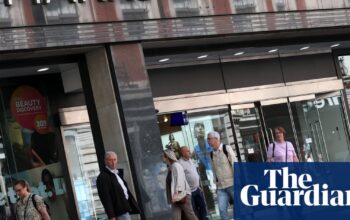
There’s a video format spreading on TikTok. Recorded in towns across suburban England, teenage interviewers stop their peers on the street, fielding questions that range from fashion choices to humorous hypotheticals and local neighbourhood dramas, in the process building a large social media following and showcasing their patch of land to the world. “950 [pounds] for that, you know my ting,” a teenage white boy says about his Canada Goose jacket in a video recorded in Bury St Edmunds. “We’re checking his drip, ya dun know, you heard my man,” someone says in another video.
Both the hosts and many of the interviewees speak with this distinct drawl – Multicultural London English (MLE), a dialect born in London’s African-Caribbean communities in the 1970s and 80s. (Some now argue that “Black British English” is a more fitting term.) It’s rooted in Jamaican patois with influences from cockney, and more recently Arabic, the US and West African Pidgin English.
A primary cause of this spread – which goes beyond viral TikToks – is British rap, with drill, grime and more taking new linguistic styles to the far corners of the country. In some cases, the entire cultural spread of MLE is contained in a single song. “I’m giving them UK slang / My brudda, my fam, my akh / You say: ‘The feds just done a sweep’ / We say, ‘The boy dem run in my gaff’,” Central Cee rapped in a 2022 freestyle, nodding to patois, cockney and Arabic respectively – akh is an Arabic word that has fed into MLE from the British Somali community, who are among both the largest Muslim and Black communities in Britain. Elsewhere, west African slang and dialects have continued to creep into British rap. Drizzled on to songs by the likes of Skepta, J Hus and NSG, terms such as wahala (trouble), “let me land” (let me finish) and juju (ancient African spiritual belief systems) are a reflection of how African communities are carving themselves deeply into British soil.
“You have quite a long history of British vernaculars being exported through British cultural forms,” says Christian Ilbury, a lecturer in sociolinguistics at the University of Edinburgh – from Scouse accents with the Beatles to Arctic Monkeys and the presence of industrial working-class accents in indie music. “Grime essentially became the vehicle in which we perceived MLE.” Those kids in suburban England, he says, “don’t speak this variety because of where they grew up. They’re using it to align with a cultural orientation that they appreciate.”
In recent years, the audience for UK rap has broadened, flowing out of inner cities. Key to its spread was the internet, which tore down the music industry’s traditional barriers to access and spread this new way of speaking. “Social media has played a huge role,” says Rob Drummond, professor of sociolinguistics at Manchester Metropolitan University. “Everybody can access everything, so it’s going to spread faster. Young people are maintaining communication all the time through Snapchat and WhatsApp. It makes it much more immersive and immediate.”
Ilbury agrees: “With social media, you get representations of MLE that transcend geographical boundaries.”
Also key is the particular appeal of Black pop culture, as defined by US writer and activist Kevin Powell in a September 2000 interview with Time: “You cannot discuss Black music without taking into account its edginess … its rebelliousness … and the fact that edginess and rebelliousness ultimately appeals to white young people as much as it does to Black young people.”
That dynamic took root in Britain in the 1970s, when various forms of reggae – also subversive and at times perceived as anti-establishment – became distinctly British iterations of a Black coolness that appealed to younger white audiences.
In the early 70s, slang in wider London revolved heavily around “East End, white working-class slang, with some Yiddish and with some [Romany-derived queer slang] Polari,” says Tony Thorne, director of the Slang and New Language Archive at King’s College London. Things began to shift in the middle of the decade, he says, when “a lot of younger white kids got into reggae and later into dancehall and dub,” and started to “pick up slang that wasn’t from the old varieties”. They were leaning into the patois present in the music, and subsequently in MLE, with phrases like “yard’ (house) and “babylon” (establishment or police).
They were leaning into the patois present in the music, and subsequently in MLE. “Jamaican culture in London,” says Thorne, was perceived as “super cool. The mods loved it, then later skinheads and punks loved it.” He remembers the music spreading into London’s whiter suburbs, but not reaching further because the genres “weren’t really global at all, they were still local” – and there was no internet to spread them onward.
Now, with digitally distributed British rap speaking to an expanded audience, this dynamic has started to play out nationally. When grime erupted in 2014, it arrived with a distinct sense of fashion and language – words like “bait”, “gassed” and “ends”, as well as distinct attire consisting of tracksuits and streetwear. It was more than just a genre: it was a culture. “And how do you express your alignment with grime music?” says Ilbury. “You start speaking in a way that sounds like MLE.” Since then, drill and a new generation of UK rappers have arrived with a similar impact: words such as ting and certi (certified) ever-present in the sound, alongside streetwear brands including Trapstar, Hoodrich and Corteiz. Ronan Bennett’s TV drama series Top Boy has also become enormously popular.
Many of the most high-profile British rappers of recent times have been men, so MLE “is often heard as extremely masculine” by wider Britain, Ilbury notes, and therefore, “often associated with young men”. As a result, the dialect seems to have resonated more strongly with teenage boys in the suburbs. Drummond says that the music, and therefore the language associated with it, carries for young men in these regions, “what we might in linguistics call a ‘covert prestige’”.
In Drummond’s field studies in Manchester, he noticed that the dialect was more likely to be used by boys, with girls maintaining their more regional ways of communicating. “Using particular ways of speaking for these young people, especially young men, is a way of performing an identity,” he says. “But unfortunately, it comes with a whole load of baggage that maybe they’re not quite ready for.”
These developments come with questions of cultural appropriation. They also highlight the racially loaded demonisation of MLE as a language associated with “roadmen”, where in increasingly popular TikTok and Instagram skits, “roadman” has become a byword for low intelligence and stupidity.
Linguists note that many of these young white men from middle England are likely to drop MLE when they move into more professional environments. But MLE’s current popularity will likely leave a permanent mark, with the dialect already becoming a standardised part of white British speech. “Even when they dial it down because they get a nice responsible job in a bank, there’s still a fundamental change,” Drummond says. “It’s like a tide. You’ve got a big wave coming in, and that dies down, but the tide is still moving in that direction.”
Source: theguardian.com



